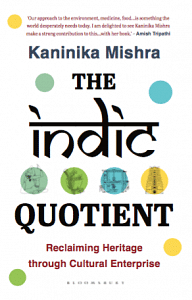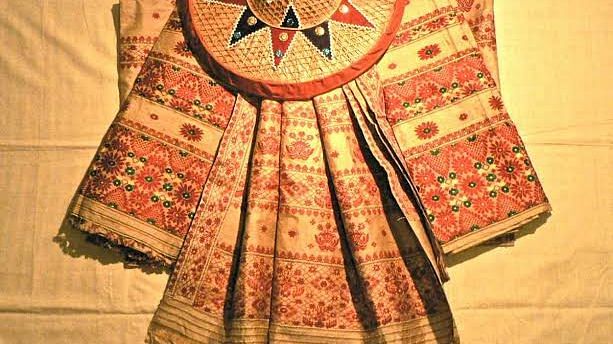The fate of handloom is closely linked with the popularity of its sarees. Sarees are the primary output from the looms in most regions of India. This is why Sanjukta Dutta, a designer based in Assam, was deeply concerned with the decreasing popularity of the Assamese handloom two-piece saree mekhala chador among young Assamese women. Unlike Kanjeevarams or Banarasi sarees, Assam’s silk sarees are not popular across the country. ‘I wanted to do my bit for this beautiful art of Assam,’ she says . I am at her spacious retail studio in an old, leafy part of Guwahati. The shop assistant helps a customer try on a grey and orange mekhala chador— one part is wrapped like a sarong and the other, draped first around the waist and then pulled over the left shoulder. There are full-length sarees in the glass shelves on the far end of the hall. The fabrics are resplendent. The colours are stark with motifs and patterns woven in bright gold.
Dutta, an engineer, used to work with Public Works Department (PWD) before she became a design entrepreneur. Moved by a desire to save Assamese handloom, Dutta quit her job and set up a small workshop in 2012. She bought three looms and employed a few weavers from the nearby town of Sualkuchi, a place known for its centuries- old weaving traditions.‘All the weavers took the advance and ran away,’ Dutta summarizes her first few weeks of being a businesswoman in a sentence for me. She explains that the market rate for weaving was so low that weavers quit the profession on finding jobs elsewhere.To make the weavers’ job sustainable, Dutta increased payments up to three times the market rate.‘Incomes have to be reasonable for artisans to continue the traditional vocation,’ she says.
Assamese silk mekhala and sarees are made from the two major types of indigenous silks produced in Assam: muga and mulberry. Muga silk, produced from the silkworm Antheraea Assamensis, endemic to Assam, is known for its durability and shine. The silk can be hand-washed and its lustre increases with each wash. Pat silk, or mulberry silk, of Assam is made from the cocoons of the pat silkworm, which feeds on the mulberry plant. Keeping up with the tradition, the muga sarees from Sanjukta Dutta’s studio are woven in their original beige colour with red motifs, while the mulberry silk yarn is dyed in various colours before it is woven. Dutta calls the assistant and asks her to bring me a sample of the yarn. The girl hands me a skein of black mulberry silk. I feel it against my cheek. It is incredibly soft.‘It’s beautiful, isn’t it?’ Dutta beams and her soft Assamese features light up withpride.
A major portion of Sanjukta Dutta’s work involves making custom-designed wedding sarees. ‘I’ve become a wedding designer, by default,’ she says and laughs softly. It is a title she does not mind. Dutta feels happy to see young Assamese women wear traditional sarees. ‘Young women weren’t wearing Assam silk even in weddings; they were bored of typical beige and red combinations and motifs. My colours and designs have brought the tradition back into fashion.’ like many designers in the handloom space, Dutta uses digital platforms extensively to promote her brand and highlight the exacting process that goes behind crafting the collections. She has also showcased her work at fashion weeks in Mumbai and Delhi, where film actresses and celebrities have worn her sarees.
Swiping images on her phone from right to left, she shows me the picture of a model wearing a black gown.
Made with mulberry silk, the backless gown had been designed on order for a model by the organizers of the 2019 Cannes Film Festival. ‘They found me on Facebook,’ Dutta smiles. This transaction between Dutta and the Cannes, a well-known French national icon, is more than a business deal. It symbolizes India’s growing cultural influence on the world stage, which in recent years has been driven, to a large extent, by the ability of Indian entrepreneurs to imaginatively interpret their heritage in new ways.
Sanjukta Dutta asks her store manager to take me to the factory located a little distance away. He leads the way on a motorcycle and asks my taxi driver to follow. We pass through quiet lanes lined with palm trees and quaint homes with faded facades. The motorcycle stops in front of a house. The factory is located in the front yard. It has walls of bamboo matting and a roof made of thatch. Inside, the place is brightly lit by fluorescent lights. The looms stand next to one another. Women in nightgowns work on the machines while children play on the floor. A few men hang around looking after the kids.
The air is leisurely and the women are unhurried. A song plays from a mobile phone plugged into a socket at one end of the hall. The looms have a wooden frame similar to the ones in Maheshwar; the process, though, is slower. unlike the plain Maheshwari, the Assam saree has motifs that run across the length of the saree. A grey card with punch-holes guides the threads at the top of a shaft for weaving the motifs designed by Dutta, but the process is deliberate and time-consuming. I look incomprehensibly over the artisan’s shoulder trying to understand the procedure. When she glances back, I ask her how she learnt to weave. I am not sure if she understands me. The taxi driver has joined me inside the factory. He chips in, ‘They learn from their mothers. I have a loom at home. My wife weaves sometimes. My daughter is only five and she is already learning.’
Also read: Tourist to ambassador — how Europeans like Jenny Housego revived Indian craft
At the time when fashion designers are successfully modernizing the handwoven saree and giving a new urban sensibility to traditional craft for their clients, a commercial Hindi film Sui Dhaaga generated awareness among the wider public. For the film’s promotions, the handcrafted versions of the title had been made by 14 designers across the country. Dutta also created the banner of Varun Dhawan and Anushka Sharma-starrer in Assam silk. The story of Sui Dhaaga revolves around a married couple, a tailor and an embroiderer, and their struggle to set up their own garment business; the film’s producers Yash Raj Films (YRF) capitalized on the growing interest in Indian traditions and heritage and used the richness of Indian handicrafts to gain leverage for the film’s publicity. Manan Mehta, VP Marketing and Merchandising, YRF, believes the campaign increased awareness of India’s culture amongst today’s youth and celebrated our country’s diversity and entrepreneurial spirit.
Dutta features in the slick marketing video that showcases her beloved Assam silk, explaining the journey of the fabric from cocoon to cloth. The video ends with a close-up of the banner with the words Sui Dhaaga written in red and in Devanagari script on Dutta’s handmade beige muga silk fabric. The video was released on national Handloom Day in 2018.

This excerpt for The Indic Quotient: Reclaiming Heritage through Cultural Enterprise has been published with special permission from Bloomsbury.




Mekhala chador is NOT a saree. Please refrain from homogenising a uniquely Assamese garment with the saree. You may say that it resembles a saree for easy reference of your readers. But making it one with the saree betrays cultural homogenisation.